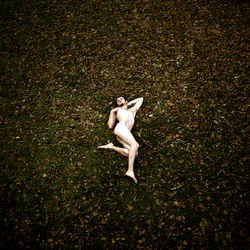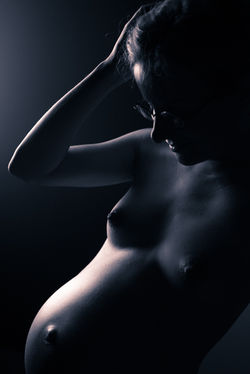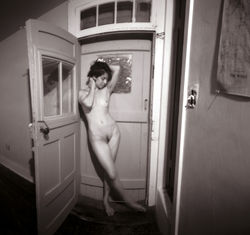
Body 2016
A juried international photography exhibition
January 21, 2016 – February 16, 2016
 |  |
|---|---|
 |  |
 |  |
 |  |
 |  |
 |  |
 |  |
 |  |
 |  |
 |  |
 |  |
 |  |
 |  |
 |  |
 |  |
 |  |
 |
The human body has been the central subject of various photographic genres. From documentary, event and street photography to fashion photography and the nude, photographers have always found ways of constructing images in which the specific portrayal of the human body gains significance. That significance may stem from the rich layers of meanings emerging from specific socio-cultural contexts, the visual interaction of the human body with the surrounding physical space, or the intriguing compositional possibilities offered by the body itself. When focussing on the body, some photographers explore movements, study expressive gestures and postures, or concentrate on the beauty and details of the human anatomy. Some narrate whole life stories through the depiction of the human body. Others may offer stern visual criticism of our normative conceptions of the human body and its mainstream representation in Western media.
Juror's choice
Marina Poliakova: Bridegrooms? No. 8
Honourable mentions
Lars Andreas Dybvik: Untitled No. 4
Rebecca Moseman: Arm
Skip Stone: Kali
Exhibiting photographers
Cristina Amiran & Khalil Charif (Rio de Janeiro, Brazil), Elimelec Berríos (San Juan, Puerto Rico), Julia Biro (London, UK), Marco Castelli (Firenze, Italy), Nina Chung (New York, NY, USA), Lars Andreas Dybvik (Trondheim, Norway), Tom Elkins (London, UK), Mary Fashbaugh (Los Angeles, CA, USA), Diane Fenster (Pacifica CA, USA), Nicolina Fota (Limassol, Cyprus), Felipe Gavioli (São Paulo, Brazil), Luisa Hübner (Vienna, Austria), Valer Inovo (Minsk, Belarus), Rachel Jump (Chicago, IL, USA), László György Király (Kecskemét, Hungary), Andras Ladai (Berkeley, CA, USA), Antonio Jacob Martinez (Carbondale, IL, USA), Dan McCormack (Accord, NY, USA), Rebecca Moseman (Purcellville, VA, USA), Lake Roberson Newton (Memphis, TN, USA), Kuo-Chin Ni (Taoyuan, Taiwan), Michal Pachniewski (Ilawa, Poland), Min Kim Park (Chicago, IL, USA), Jorge Pedra (Porto, Portugal), Marina Poliakova (Kiev, Ukraine), Susan Rosenberg Jones (New York, NY, USA), Erika Rózsa (Budapest, Hungary), Natasha Rudenko (Moscow, Russia), Carlo Alberto Rusca (Muralto, Switzerland), Skip Stone (Tenafly, NJ, USA), Jack Toolin (New York, NY, USA), Susan Tuttle (Maine, USA), Jia Wang (Rochester, NY, USA)
Please click on the names to see contact information (website or e-mail) where available.
Body 2016
Juror’s review
Very often when photographic images of the human body are put on display there is little or no room for reflexion on the act of producing and presenting these images. The photographs of this exhibition, however, do not let us move on without making an effort to understand why they were created and why we consider them significant.
The juror’s choice is Marina Poliakova’s Untitled No. 10 from the series “Bridegrooms?”. All images in the series portray a male character posing in the nude; the ways in which their bodies are arranged and the settings in which they appear are easily recognised from mainstream magazine photos of naked women. Female nudes on display in bucolic natural settings, looking at the viewer with a calculatedly charming, seductive expression, is such an overused visual cliché that it takes a few seconds for the fact to really sink in that we are looking at male figures here. The recognition of the male bodies is further complicated by their poses. It is likely not the first time that the viewer is confronted with male characters assuming poses commonly associated with female models in paintings or magazine photos; however, this aspect of the series is also very effective in raising questions about gender roles and their corresponding visual topoi. Although some of the models are characteristically, or even exaggeratedly, masculine in their physical appearance, the figure in image No. 8 has features akin to the female bodies that we usually encounter in this type of contexts. He has delicate bones, thin arms and legs, and a very light skin. His unnaturally twisted body, specifically emphasizing and exposing his breast and legs for the viewer is set against the darker background of grass and leaves. We can hardly not notice that this is precisely the type of image that successfully makes its way to the mainstream visual representation of women again and again. So what happens when the gender roles and representational routines are switched?
Untitled No. 4 by Lars Andreas Dybvik is the first honourable mention. It features a conventional female nude pose but in a surprisingly geometrical space, thus adding a layer of playfulness to the photograph. The soft tones and curves of the body are at odds with the strict and repetitive pastel lines of the corridor, the doors and the carpet, and that creates an interesting tension in the image. Rebecca Moseman’s Arm grabs and holds our attention with the elegant simplicity of the unusual crop. We need to study the boy’s arm carefully to realise how detailed it is with its tiny freckles as opposed to the more homogenous surface of the torso and the blackness of the background. The third honourable mention is Skip Stone’s Kali. The photo shows the body of a pregnant woman captured in a statue-like three-dimensional composition of strength and balance. The image diverges considerably from the usual portrayals of expecting women, and takes us far away from the clichéd, and often romanticised, stereotypes of the pregnant body.
Marco Castelli’s No. 1, from the series “The Big Nudes” invites us to a fragmented but at the same time coherent perceptual experience created by a composition of many separate images of parts of a nude, taken from many perspectives. 2013082719-55-37, from the series “Contours” by Tom Elkins makes the viewer realise just how few short lines are sufficient to define the shape a human body in three dimensions. Felipe Gavioli’s Odradek No. 2 lets us peak into a ghostly disappearing world of a ghostly disappearing body. The eyeglasses, the nipples, the tip of the elbow and the belly button of the pregnant woman serve as the focal points for the eye’s journey in Maternity No. 1 by Andras Ladai. Susan Rosenberg Jones’ Bonsai and Joel, from the series “Second Time Around” is a most intimate photograph of a loved one in a cosy place with golden lights. UCC1SUBH3, from the series “Ultra Corpo Ciclo 1” by Carlo Alberto Rusca reveals (some of) what is under our skin with the help of a modified camera that captures light frequencies invisible to the naked human eye.
With such diverse approaches and interests the images of these exhibition present a wide variety of photographic interpretations of the theme. They range from formalist inquiries to the critique of our social and representational norms, reminding us that there is always something new to discover when we turn our attention to the human body.
Zsolt Bátori

